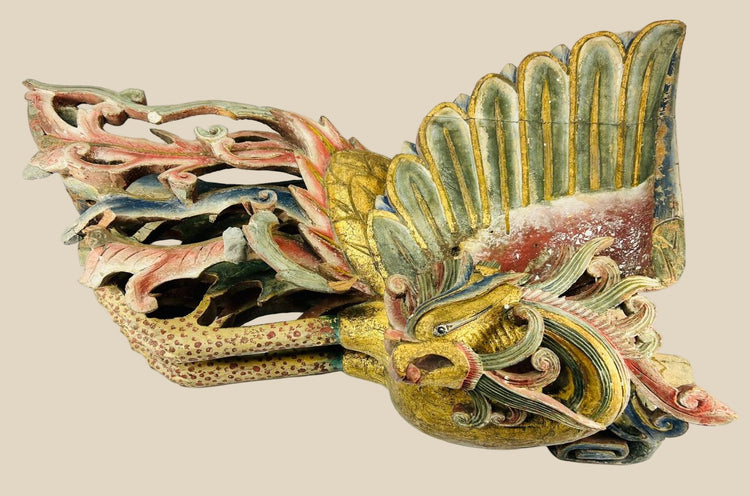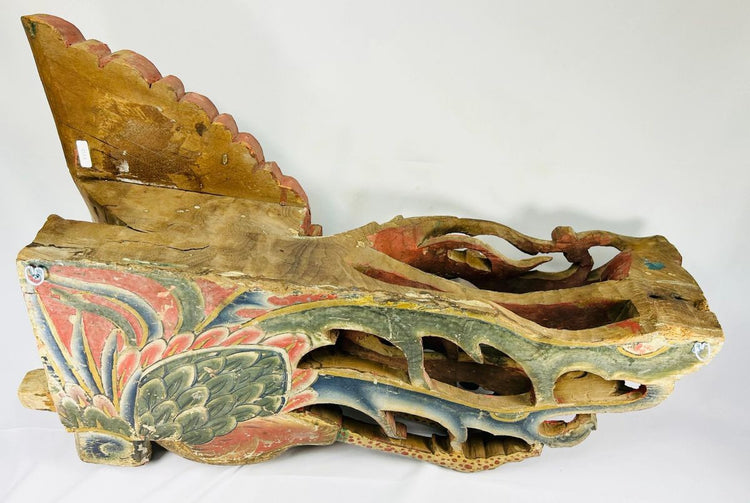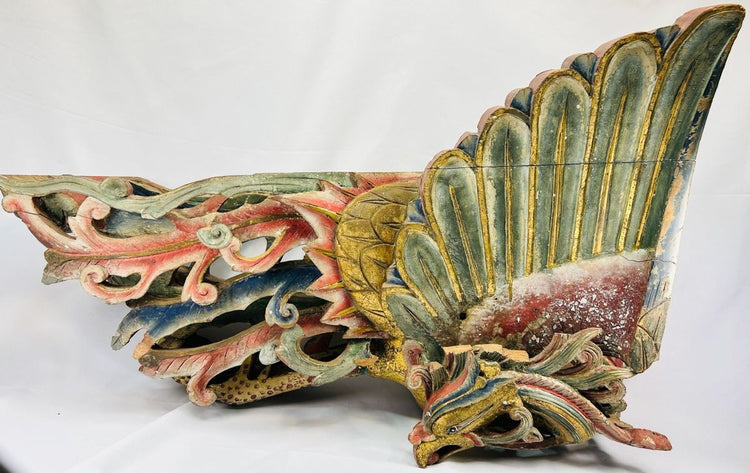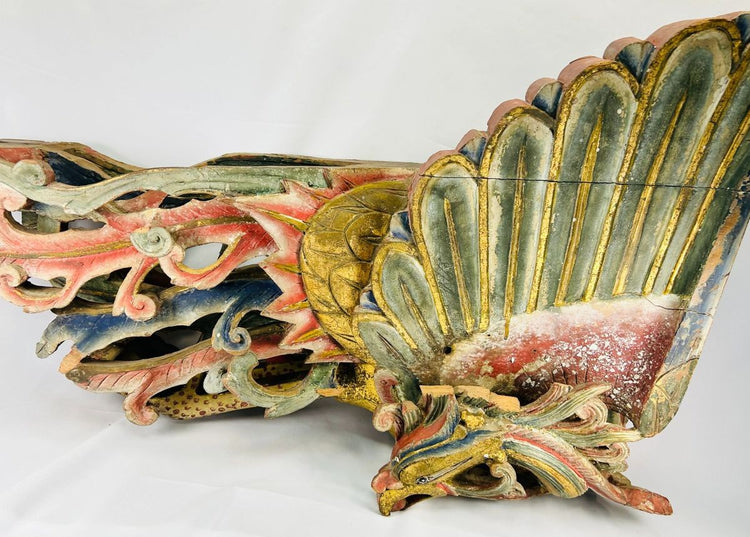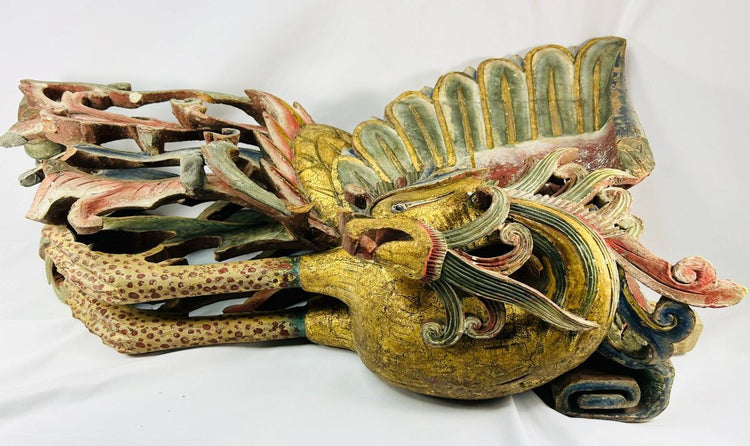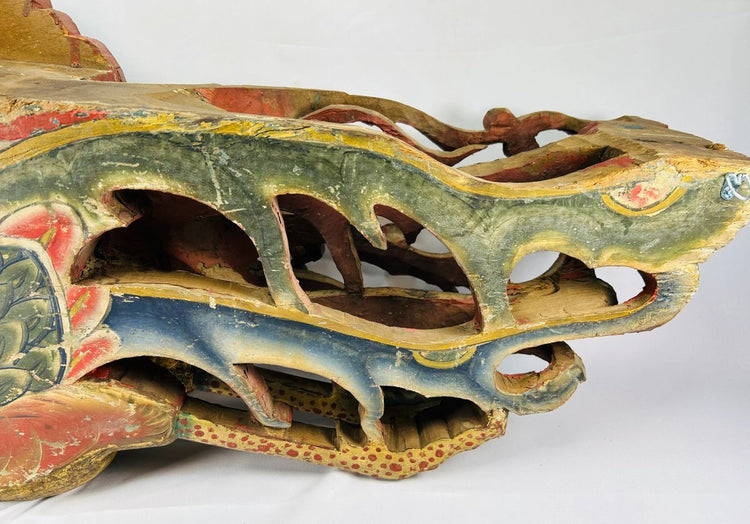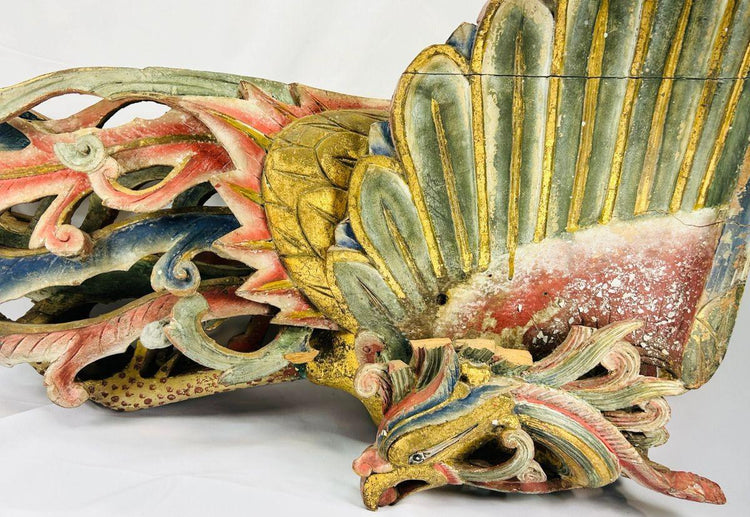Corbeau chinois polychrome en forme de phénix du XIXe siècle – Temple sculpté à la main et doré
Description
Plus
Moins
Contexte historique et origine
Région : Chine
Matériau : Bois de camphre sculpté et peint à la main avec des reflets dorés
Période : Milieu du XIXe siècle
Description
Cet élément architectural exquis, sculpté à la main dans du bois de camphre, représente le phénix, symbole intemporel de la mythologie chinoise, symbole d'immortalité, de renouveau et de prospérité. La sculpture le présente en plein vol, les ailes déployées et le cou gracieusement arqué, incarnant à la fois élégance et dynamisme. Chaque plume est minutieusement détaillée, rehaussée de touches de dorure et de riches pigments polychromes rouges, verts et bleus. Sa tête à la fois féroce et raffinée, sa crête ondulante et son œil peint d'un noir intense confèrent à la figure une présence imposante. Conçue à l'origine pour un temple ou un édifice architectural important, cette pièce illustre la sophistication et le symbolisme spirituel de l'artisanat chinois du XIXe siècle.
Caractéristiques
- Phénix en pose dynamique en plein vol avec les ailes levées et le cou plié
- Plumage finement sculpté avec des reflets dorés et polychromes
- Tête féroce et royale avec une crête fluide et des détails oculaires peints
- Riche palette de rouge, d'or, de bleu et de vert signifiant vitalité et prospérité
- Sculpture à grande échelle en bois de camphre avec des textures superposées pour plus de profondeur
Importance culturelle
Dans la tradition chinoise, le phénix (Fenghuang) est considéré comme un symbole de renaissance, d'harmonie et de puissance divine. Des sculptures architecturales comme celle-ci étaient souvent placées dans les temples ou les sites culturels importants pour invoquer bénédictions, protection et prospérité pour la communauté. Cette pièce représente non seulement un symbolisme mythologique, mais témoigne également du raffinement artistique des artisans de la dynastie Qing, qui allient dévotion et maîtrise décorative.
Condition
La sculpture est en excellent état pour son âge, avec des traces éclatantes de peinture polychrome et de dorure d'origine encore visibles. L'usure naturelle, les intempéries et les légères pertes dues au temps sont présentes, mais n'altèrent en rien son impact visuel saisissant. La patine ajoute une authenticité historique, soulignant son rôle d'objet sacré et décoratif.
Dimensions (approximatives)
Longueur : 28 po
Âge
Plus de 150 ans
Description
Contexte historique et origine
Région : Chine
Matériau : Bois de camphre sculpté et peint à la main avec des reflets dorés
Période : Milieu du XIXe siècle
Description
Cet élément architectural exquis, sculpté à la main dans du bois de camphre, représente le phénix, symbole intemporel de la mythologie chinoise, symbole d'immortalité, de renouveau et de prospérité. La sculpture le présente en plein vol, les ailes déployées et le cou gracieusement arqué, incarnant à la fois élégance et dynamisme. Chaque plume est minutieusement détaillée, rehaussée de touches de dorure et de riches pigments polychromes rouges, verts et bleus. Sa tête à la fois féroce et raffinée, sa crête ondulante et son œil peint d'un noir intense confèrent à la figure une présence imposante. Conçue à l'origine pour un temple ou un édifice architectural important, cette pièce illustre la sophistication et le symbolisme spirituel de l'artisanat chinois du XIXe siècle.
Caractéristiques
- Phénix en pose dynamique en plein vol avec les ailes levées et le cou plié
- Plumage finement sculpté avec des reflets dorés et polychromes
- Tête féroce et royale avec une crête fluide et des détails oculaires peints
- Riche palette de rouge, d'or, de bleu et de vert signifiant vitalité et prospérité
- Sculpture à grande échelle en bois de camphre avec des textures superposées pour plus de profondeur
Importance culturelle
Dans la tradition chinoise, le phénix (Fenghuang) est considéré comme un symbole de renaissance, d'harmonie et de puissance divine. Des sculptures architecturales comme celle-ci étaient souvent placées dans les temples ou les sites culturels importants pour invoquer bénédictions, protection et prospérité pour la communauté. Cette pièce représente non seulement un symbolisme mythologique, mais témoigne également du raffinement artistique des artisans de la dynastie Qing, qui allient dévotion et maîtrise décorative.
Condition
La sculpture est en excellent état pour son âge, avec des traces éclatantes de peinture polychrome et de dorure d'origine encore visibles. L'usure naturelle, les intempéries et les légères pertes dues au temps sont présentes, mais n'altèrent en rien son impact visuel saisissant. La patine ajoute une authenticité historique, soulignant son rôle d'objet sacré et décoratif.
Dimensions (approximatives)
Longueur : 28 po
Âge
Plus de 150 ans
Vous aimerez peut-être aussi


























